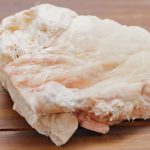 The chopped up animal fat that my mother used to strew on snow banks for sparrows to eat is called suet, a product also added to steamed puddings and mincemeat (in the Middle Ages it was also rubbed on swords and iron hinges to keep them from rusting). The name of this multi-purpose animal-product derives, through French, from the Latin sebum, which is what the ancient Romans called animal fat. First recorded in English in the late fourteenth century, suet was joined in the eighteenth century by the word sebum itself, which was adopted as a name for the fatty secretion exuded by the human scalp, a secretion that lubricates one’s hair. Slightly later in the eighteenth century, sebum also gave rise to sebaceous, a word meaning unctuous, greasy, in dire need of shampoo.
The chopped up animal fat that my mother used to strew on snow banks for sparrows to eat is called suet, a product also added to steamed puddings and mincemeat (in the Middle Ages it was also rubbed on swords and iron hinges to keep them from rusting). The name of this multi-purpose animal-product derives, through French, from the Latin sebum, which is what the ancient Romans called animal fat. First recorded in English in the late fourteenth century, suet was joined in the eighteenth century by the word sebum itself, which was adopted as a name for the fatty secretion exuded by the human scalp, a secretion that lubricates one’s hair. Slightly later in the eighteenth century, sebum also gave rise to sebaceous, a word meaning unctuous, greasy, in dire need of shampoo.
A hard fat from cattle or sheep kidneys and loins, used as the base of certain ointments and as an emollient.
The rigid, ivory-colored fat that encases the loins, heart, and kidneys of various domesticated animals, with beef and mutton being common examples.
The adipose tissue enveloping the kidneys and loins of sheep and cows, renowned as suet, occupies a prominent role in numerous traditional English culinary preparations. In Great Britain, this esteemed ingredient is procured through two common avenues. It can be acquired directly from the butcher, manifesting as solid lumps of fat. Alternatively, one may opt to purchase it from the grocer, where it is conveniently grated and thoughtfully packaged, readily available for utilization in various gastronomic endeavors.
